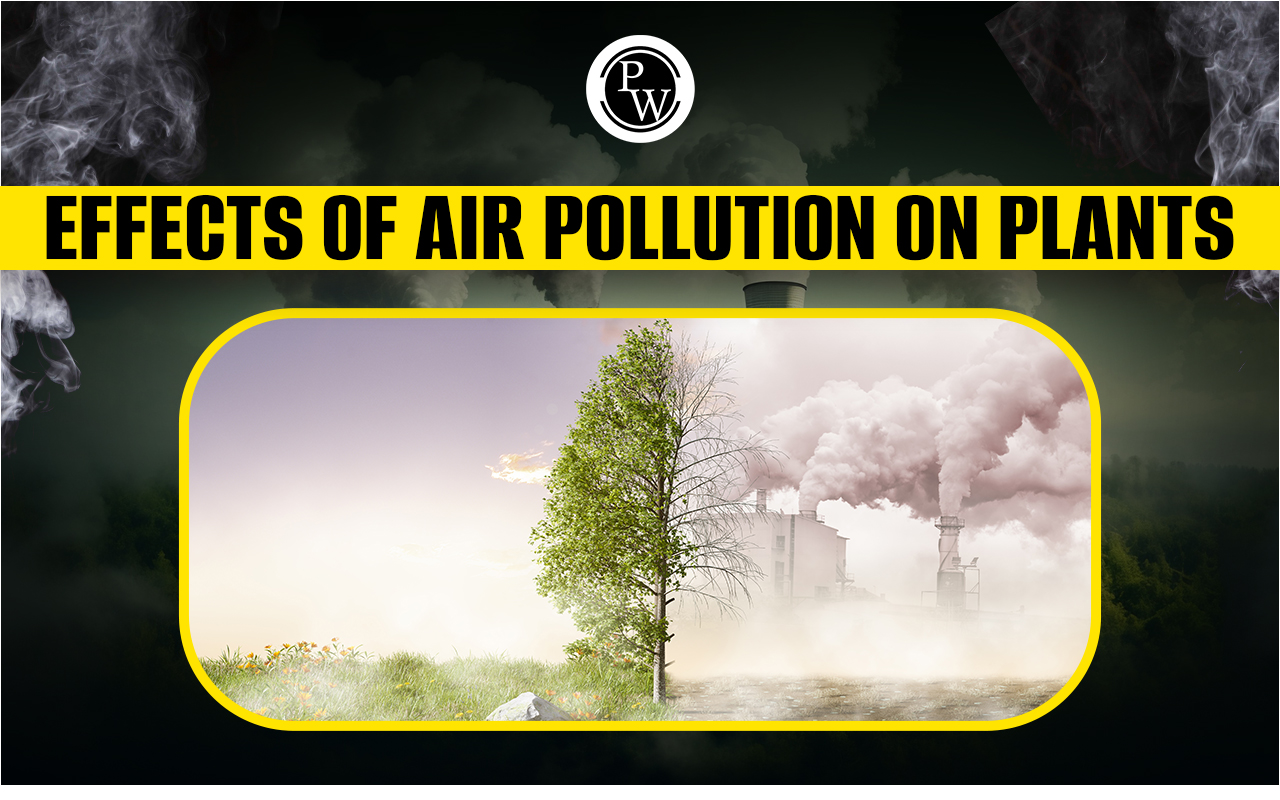

Effects of Air Pollution on Plants: Plants are delicate beings involved in the purification of the environment, enrichment of the soil, releasing oxygen, and removing excess Carbon dioxide. These organisms utilise specialised machinery and cells like chloroplasts to produce their food through photosynthesis.
This process requires optimum conditions like temperature, rainfall, air pressure, and so on to occur. Due to pollution, these conditions alter, and the plant’s capacity to produce glucose is reduced. The soft tissues of the plant body get affected by all forms of pollution, which eventually degrades the quality of leaves and stems and hampers root growth. The sources of pollution may not always be visible to the eyes, but the deviation of plants in that region from normal growth can indicate and point toward the source. In this article, we will discuss how the various sources of pollution affect plants and their growth in detail.Effects of Air Pollution On Environment
Introduction to Pollution
When introduced into the environment, any substance disturbs the normal ecological balance, damages flora and fauna, and destabilises the biotic and abiotic components a pollutant, and its effects give rise to Pollution.- Natural pollutants include volcanic ash, pollen grains, and so on. Pollutants can also be caused by human activities, such as factory runoff or waste. The quality of the air, water, and soil degrade due to pollution.
- As more and more pollutant gets introduced into the environment, their concentration and toxicity slowly increase, and their ability to affect living organisms rises exponentially. When the pollutants in a region increase beyond control, the area becomes inhabitable, and the region's biodiversity gets lost.
- The effects of Pollution are not limited to one species or environment. Plants, animals, and even microorganisms are affected by pollutants because of their ability to hamper metabolic activities. Plants are especially affected by air pollutants, microbes are affected by salt and water pollutants, and animals are affected by all types of pollutants.
- Pollution affects the pre-existing resources and reduces the renewability of these resources by interfering with ecological processes. For instance, excess air pollution reduces the ability of plants to create more oxygen, thereby affecting the air quality even more.
Types of Pollution
A Pollutant can exist in various forms, and its effects on abiotic factors like air, water or soil depend upon its physical form and chemical properties. Based on the type of abiotic factor it affects, Pollution can be divided into the following categories:Air Pollution
Air Pollution is the degradation of the atmosphere and imbalance in the gaseous concentration due to the introduction of harmful gases into the air.- This ty[pe of Pollution reduces the amount of dissolved oxygen in the air which is necessary for the survival of all animals. In the changed environment, animals undergo mutations, their size and lifespan reduce, and several diseases develop.
- The rise in the concentration of Greenhouse gases like carbon dioxide forces the temperature of the EWarth to rise by trapping the sunrays normally reflected by Earth’s surface.
- Global warming causes the melting of the polar ice caps, rising sea levels, and increasing the risk of flood and other natural calamities.
- The continuous release of Cluroflurocarbons from Air conditioners, refrigerators, and vehicle coolants damage the Ozone layer in the stratosphere, giving rise to Ozone holes. This hole allows harmful Ultraviolet rays to penetrate the troposphere and spread radiation damage.
- As the Air quality index degrades, the quality of life, especially among humans, also leads to diseases like Asthma, Breathing difficulty, Bronchitis, and much more.
Water Pollution
Life on Earth began in water because it provided conditions like moisture, dissolved oxygen, nutrients, and minerals that allowed the biomolecules to combine and perform the metabolic exchange.- When the waste materials like sewage and industrial waste, household wastes, plastics, and other pollutants are introduced into water bodies, the ability of water to support life is reduced, leading to Water Pollution.
- Water Pollution affects all life forms because every organism requires water in some form. Plants and animals utilise water for vital processes like Respiration, Transpiration, Nutrient absorption, etc.
- Polluted water carries less dissolved oxygen, minerals, and ions and has high toxicity. These factors make life difficult for organisms living in the water bodies.
- The First indication of Water Pollution is the reduction of the fish population, overgrowth of algae, and change in color and smell and the water body.
- Non-degradable wastes like plastics and E-wastes reach the depths of seas and oceans and remain, therefore, slowly releasing chemicals and mutating the local environment for millions of years.
- Human activities are mainly responsible for water pollution because the waters are directly dumped into water bodies without any filtration to save the cost of purification.
Double Fertilization In Angiosperms
Related Links -
Soil Pollution
Unethical agricultural practices like frequent chemical fertilisers, Insecticides, and Pesticides to increase agricultural yields introduce pollutants and toxic substances into the soil leading to Soil pollution.- Although the crop yield and soil quality may seem to increase initially, the concentration of these chemicals keeps rising, eventually making the soil completely lifeless and infertile.
- These pollutants damage the microenvironment of the soil, killing good bacteria, earthworms, and other organisms, which help break down organic matter into nutrient-rich humus.
- In the absence of these nutrients, the large trees fail to grow to their full potential, do not generate enough oxygen, and fail to remove carbon dioxide from the soil. Thus, one pollution leads to another, causing complete catastrophic failure.
- These insecticides and pesticides also get carried away to water bodies, causing water pollution.
- The damage to the trees affects rainfall and weather patterns, and reduces the ability of the roots to hold the topsoil together. This increases the incidences of floods, droughts, and famine, eventually causing loss of human life.
Noise Pollution
Any sound beyond the normal hearing frequency is considered Noise, and it can harm organisms' mental and physical health.- It increases irritability, causes damage to the eardrums, and disturbs the balance of microorganisms.
- Plant growth and health are also affected by Noise, and several researchers have indicated that music can promote plant growth while noise can hamper their development.
- Aircraft, vehicles, loudspeakers, and industries are among the leading causes of Noise pollution.
Causes of Pollution
Although Pollutants exist naturally, Human activities are the primary cause of the rising pollution because the rate of damage from man-made activities is beyond the ability of normal repair. Some of the primary causes and sources of pollution include-- Release of harmful gases like sulfur oxides from vehicles like cars and motorcycles.
- Release of harmful gases like Nitrous oxides from aircraft.
- Release of CFCs from Airconditioners and refrigerators.
- Release of smoke from chimneys in industries.
- Release of chemicals from fertilisers and insecticides into water bodies.
- Dumping of industrial effluents into rivers and oceans.
- Release of plastics, metal, and electronic waste into oceans.
- Filling of landfills from household wastes.
- Honking of horns, loud music, and supersonic aircraft leading to noise pollution.
- Deforestation and removal of trees resulting in nutrient and water cycle imbalance.
- Acid raisin due to intermixing of gaseous exhausts with water.
Difference Between Plant Cell And Animal Cell
Effects of Air Pollution on Plants
Plants are affected by all sources of pollution, including air, water, soil, and even noise pollution. However, Air pollution causes the most significant damage because the growth of leaves and photosynthesis is directly dependent upon the air quality. Some of the effects caused by air pollution on plants include- Injury to leaves can manifest quickly as necrotic lesions (dead tissue), or it might take longer to occur and manifest as yellowing or chlorosis of the leaf. Different parts of a plant may develop less quickly than usual.
- Ozone effects often manifest as flecking, tanning, or burning of the leaf tissues on the top surface of the susceptible leaves. Although crop loss can happen without any indication of pollution stress, production decreases are typically accompanied by evident foliar damage.
- The major apertures via which Sulphur dioxide penetrates the leaves are the stomata, and the resulting harm can be either acute or chronic. Acute damage is brought on by the comparatively quick absorption of large amounts of sulfur dioxide. The symptoms are two-sided (bifacial) lesions, which often form along the veins and sporadically along the leaf edges. Long-term ingestion of sulfur dioxide at below-lethal amounts results in chronic damage. Leaf chlorosis, or yellowing, and bronzing on the underside of the leaves are among the symptoms in a few rare cases.
- The Flouride injury first appears as a grey or light-green moist lesion that eventually turns reddish-brown. The necrotic regions get larger with extended exposure, extending downward on monocotyledonous leaves and inward to the midrib on wide leaves.
- Complete expression of Ammonia damage, which manifests as irregular, bleached, bifacial, necrotic lesions, often takes several days to develop on damaged plants. Grasses frequently display dark top surface discoloration or reddish, interveinal necrotic streaks. Flowers, fruit, and woody components are often unaffected, and when fruit trees suffer serious damage, regeneration through the growth of new leaves may occur.
- Particulate debris deposited on plants, such as cement dust, magnesium-lime dust, and carbon soot, can obstruct normal respiration and photosynthetic processes. Due to the formation of a thick crust and alkaline toxicity under moist conditions, cement dust may result in chlorosis and the loss of leaf tissue. Additionally, the dust layer may interfere with the typical operation of insecticides and other agricultural agents sprayed on plants. Additionally, the buildup of alkaline dust in the soil can cause the pH to rise to levels that are harmful to crop development.
Related Links -
Effects of Air Pollution on Plants <span style=
Does Air Pollution affect plants?
Yes, plants are affected by Air pollutants. Although the increase in carbon dioxide concentration benefits plants, other harmful gases like ammonia, fluorides, and so on damage plant tissues and induce necrosis or cell death.
What are the sources of Air pollutants that affect plants?
Fluorides are present in chemical fertilisers, Ammonia is also released from insecticides and fertilisers, and Particulate matter is released from industries having chimneys. Vehicle exhausts are also harmful to plants and trees.
What is the method to identify plants with air pollution?
The most obvious symptom that a plant is suffering from air pollution is the discoloration of the leaves. The chlorophyll cells of the leaves get blocked, and the leaves dry and turn brown.
Which method can be used to protect plants from air pollution?
Reducing the use of private vehicles and public transport, filtering industrial smoke before releasing it into the environment, and reducing chemical fertilisers are some methods that can protect plants from air pollution.
🔥 Trending Blogs
Talk to a counsellorHave doubts? Our support team will be happy to assist you!

Check out these Related Articles
Free Learning Resources
PW Books
Notes (Class 10-12)
PW Study Materials
Notes (Class 6-9)
Ncert Solutions
Govt Exams
Class 6th to 12th Online Courses
Govt Job Exams Courses
UPSC Coaching
Defence Exam Coaching
Gate Exam Coaching
Other Exams
Know about Physics Wallah
Physics Wallah is an Indian edtech platform that provides accessible & comprehensive learning experiences to students from Class 6th to postgraduate level. We also provide extensive NCERT solutions, sample paper, NEET, JEE Mains, BITSAT previous year papers & more such resources to students. Physics Wallah also caters to over 3.5 million registered students and over 78 lakh+ Youtube subscribers with 4.8 rating on its app.
We Stand Out because
We provide students with intensive courses with India’s qualified & experienced faculties & mentors. PW strives to make the learning experience comprehensive and accessible for students of all sections of society. We believe in empowering every single student who couldn't dream of a good career in engineering and medical field earlier.
Our Key Focus Areas
Physics Wallah's main focus is to make the learning experience as economical as possible for all students. With our affordable courses like Lakshya, Udaan and Arjuna and many others, we have been able to provide a platform for lakhs of aspirants. From providing Chemistry, Maths, Physics formula to giving e-books of eminent authors like RD Sharma, RS Aggarwal and Lakhmir Singh, PW focuses on every single student's need for preparation.
What Makes Us Different
Physics Wallah strives to develop a comprehensive pedagogical structure for students, where they get a state-of-the-art learning experience with study material and resources. Apart from catering students preparing for JEE Mains and NEET, PW also provides study material for each state board like Uttar Pradesh, Bihar, and others
Copyright © 2025 Physicswallah Limited All rights reserved.
Get App











